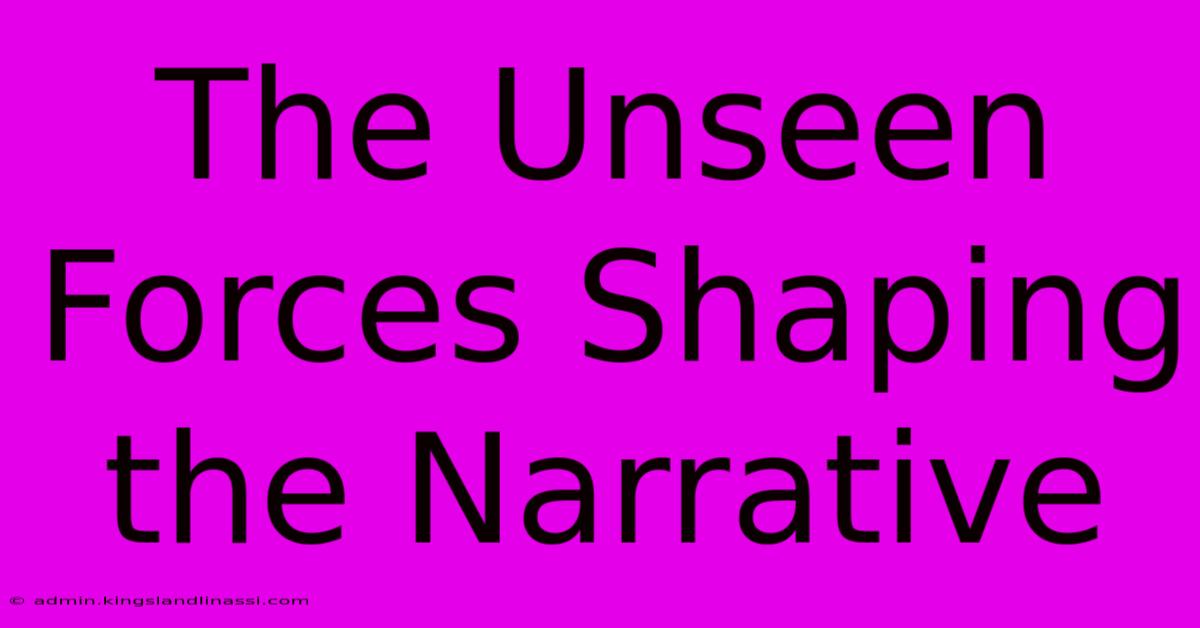The Unseen Forces Shaping The Narrative

Table of Contents
The Unseen Forces Shaping the Narrative
We live in a world saturated with narratives. From the news we consume to the social media feeds we scroll, stories are constantly shaping our understanding of reality. But what if the stories we hear aren't the whole picture? What unseen forces are subtly, and sometimes not-so-subtly, manipulating the narratives we encounter? This article delves into the hidden influences that shape our perception of the world.
The Power of Media Bias
One of the most significant unseen forces shaping narratives is media bias. This isn't necessarily about outright falsehoods, but rather the subtle ways in which information is presented.
- Selection Bias: What stories are chosen to be covered, and which are ignored? This seemingly simple decision can drastically alter public perception.
- Framing: How is a story presented? The language used, the imagery chosen, and even the order of events can dramatically influence how we interpret the information.
- Source Bias: Who is providing the information? Understanding the potential motivations and biases of news sources is crucial to critically evaluating the narrative being presented.
Understanding these aspects of media bias is crucial to becoming a more informed consumer of information. Critical thinking and media literacy are more important than ever in a world overflowing with competing narratives.
Algorithmic Influence: The Invisible Hand of the Internet
The rise of social media and algorithmic curation has introduced another powerful, unseen force shaping narratives. Algorithms, designed to optimize user engagement, often prioritize sensationalism and emotional responses over factual accuracy. This can lead to:
- Filter Bubbles: Algorithms personalize our feeds, showing us content that aligns with our existing beliefs. This creates "echo chambers" where we are only exposed to information that confirms our biases.
- Spread of Misinformation: Algorithms can inadvertently amplify the spread of false or misleading information, making it difficult to distinguish fact from fiction.
- Polarization: By reinforcing existing biases and limiting exposure to diverse perspectives, algorithms contribute to increased social and political polarization.
To navigate the algorithmic landscape, it’s essential to actively seek out diverse sources of information, critically evaluate the credibility of online sources, and be aware of the potential for manipulation.
Corporate and Political Influence: The Stakes are High
Powerful institutions, both corporate and political, often exert significant influence over the narratives that circulate in society.
- Corporate interests can shape news coverage through advertising, lobbying, and public relations campaigns.
- Political actors use media strategically to promote their agendas and shape public opinion. This can involve manipulating information, suppressing dissent, or creating narratives that benefit their interests.
Recognizing these influences requires a degree of media skepticism and a commitment to seeking out multiple perspectives.
The Role of Language and Framing in Shaping Perception
The power of language in shaping narratives cannot be overstated. The words we use, the metaphors we employ, and the way we frame information all have a profound impact on how others perceive events.
- Loaded Language: Words with strong emotional connotations can evoke specific responses and influence opinions without presenting factual information.
- Strategic Framing: Framing an issue in a particular way can drastically alter public perception. For example, framing a tax cut as a "stimulus" versus a "handout" can change how it is received by the public.
Learning to identify and analyze the language used in news articles and other forms of media is crucial to understanding how narratives are being constructed.
Conclusion: Navigating a World of Narratives
The unseen forces shaping narratives are complex and multifaceted. However, by understanding the mechanisms of media bias, algorithmic influence, and corporate/political power, we can become more critical consumers of information. Developing strong media literacy skills, cultivating critical thinking abilities, and actively seeking out diverse perspectives are crucial steps in navigating the complex landscape of modern narratives and forming our own informed opinions. Only through conscious effort can we hope to discern truth from manipulation and build a more informed and resilient society.

Thank you for visiting our website wich cover about The Unseen Forces Shaping The Narrative. We hope the information provided has been useful to you. Feel free to contact us if you have any questions or need further assistance. See you next time and dont miss to bookmark.
Featured Posts
-
Samuel Onuha How He Built His Net Worth
Apr 28, 2025
-
Won Bins Net Worth A Testament To His Talent And Dedication
Apr 28, 2025
-
The Billionaire Sons Personal Trainer Reveals All
Apr 28, 2025
-
Seventh Son 2 Beyond Good And Evil
Apr 28, 2025
-
Molly Littles Age A Story Of Determination
Apr 28, 2025
